The Form Factor, a fillet shape control parameter introduced over the past couple of releases, has been revamped and given a new interpretation in this release. It now also applies to more workflows.
The form factor can currently be found in the following tools:
- Surface > Multi-Surface Fillet > Surface Fillet
- Surface > Multi-Surface Fillet > Symmetric Fillet
- Surfaces > Rolled Edge > Fillet Flange
- Surfaces > Rolled Edge > Tube Flange
- Surfaces > Rolled Edge > Panel Gap
See also Form Factor more widely available.
Form factor and its relationship to CV distribution
The Form Factor now defines the ratio of the length of the innermost CV arms to the length of the outer (tangent) arms of the hull in the V direction of the fillet. This definition gives you greater control over the shape of the fillet.
The old relationship Form Factor = Center Radius / Tangent Offset no longer applies.
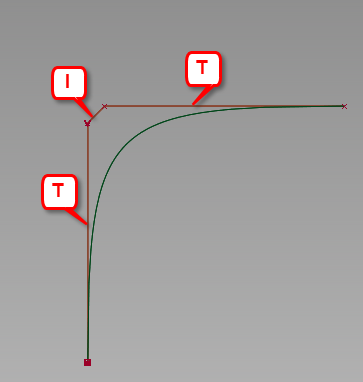
T = Tangent arms; I = Inner arm, on a degree 3 fillet
The form factor is now a number between 0.1 and 2.0 (instead of 0.1 to 1.0 as previously). Form factors are classified as "sharp" (if less than 1.0), "neutral" (if equal to 1.0), or "dull" (if greater than 1.0). This classification refers to the behavior of the curvature plot.
We explain and illustrate this concept in the next sections, for fillets of V-degree 3 to 7. As before, G1 circular fillets can have a V-degree from 3 to 6. G2 Curvature fillets can have a V-degree from 5 to 7. G3 Curvature fillets can only have a V-degree of 7.
Degree 3 form factor for G1 fillets
A fillet with V-degree = 3 has three polygonal arms - tangent, inner, tangent - in the circular direction. The form factor f, 0.1 <= f <= 2.0, defines the ratio of the length of the inner arm to the length of either of the two tangent arms. For example, if f = 0.5, the three polygonal arms are in the ratio 1 : 0.5 : 1. Degree 3 applies only to G1 fillets.
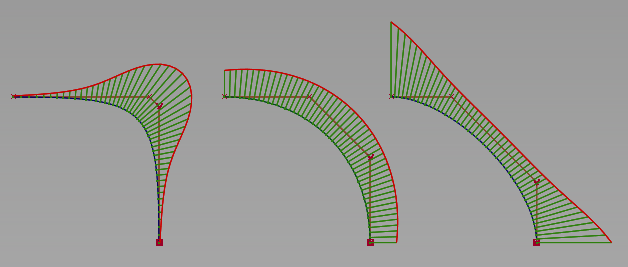
From left to right: form factor = 0.1, 1.0, and 2.0
Degree 4 form factor for G1 fillets
A fillet with V-degree = 4 has four polygonal arms - tangent, inner, inner, tangent - in the circular direction. The form factor f, 0.1 <= f <= 2.0, defines the ratio of the length of either inner arm to the length of either tangent arm. For example, if f = 0.5, the arms are in the ratio 1 : 0.5 : 0.5 : 1.
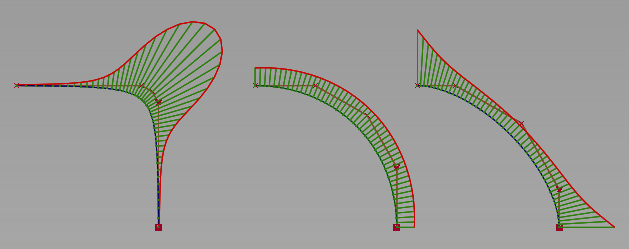
From left to right: form factor = 0.1, 1.0, and 2.0
Degree 5 form factor for G1 and G2 fillets
A fillet with V-degree = 5 has five polygonal arms - tangent, middle, inner, middle, tangent - in the circular direction. The form factor f, 0.1 <= f <= 2.0, defines the ratio of the length of the inner arm to the length of either tangent arm. For example, if f = 0.4, then the arms are in the ratio 1 : 0.7 : 0.4 : 0.7 : 1 (each middle arm has the average length of the inner and tangent arms).

From left to right: form factor = 0.1, 1.0, and 2.0
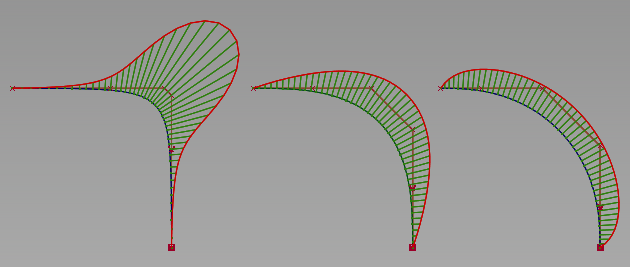
Degree 6 form factor for G1 and G2 fillets
A fillet with V-degree = 6 has six polygonal arms - tangent, middle, inner, inner, middle, tangent - in the circular direction. The form factor f, 0.1 <= f <= 2.0, defines the ratio of the length of either inner arm to the length of either tangent arm. For example, if f = 0.4, then the arms are in the ratio 1 : 0.7 : 0.4 : 0.4 : 0.7 : 1 (again, the middle arms have the average length of the inner and tangent arm lengths).
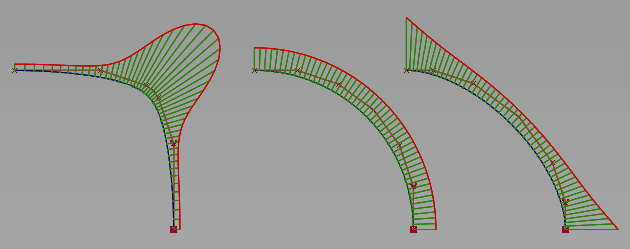
From left to right: form factor = 0.1, 1.0, and 2.0
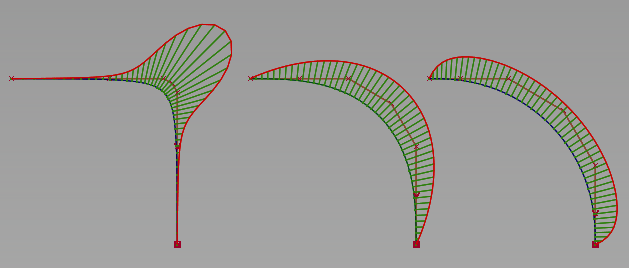
Degree 7 form factor for G2 and G3 fillets
A fillet with V-degree = 7 has seven polygonal arms - tangent, middle, middle, inner, middle, middle, tangent - in the circular direction. The form factor f, 0.1 <= f <= 2.0, defines the ratio of the length of the inner arm to the length of either tangent arm. For example, if f = 0.4, then the arms are in the ratio 1 : 0.8 : 0.6 : 0.4 : 0.6 : 0.8 : 1 (the middle arms interpolate the inner and tangent arm lengths).
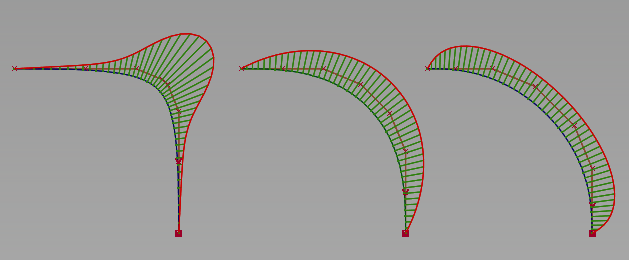
From left to right: form factor = 0.1, 1.0, and 2.0
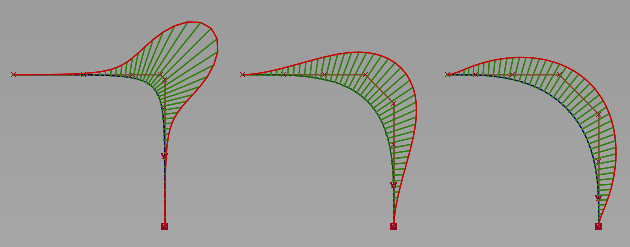
Form Factor more widely available
In Surface Fillet, the Form Factor can now be set for chordal fillets, and any type of variable fillet, and for Section Type = G1 Circular (in addition to G2 and G3 Curvature as before).
In Symmetric Fillet, the form factor now works for G1, in addition to G2 and G3 section types.
In Fillet Flange, Tube Flange and Panel Gap, you can now use the form factor for G1, in addition to G2. As in Surface Fillet, these tools also have the new setting Specify = Both that lets you specify both the Tangent Offset and Center Radius of the fillet, but not the Form Factor. The form factor is calculated automatically from these two values and varies along the fillet.